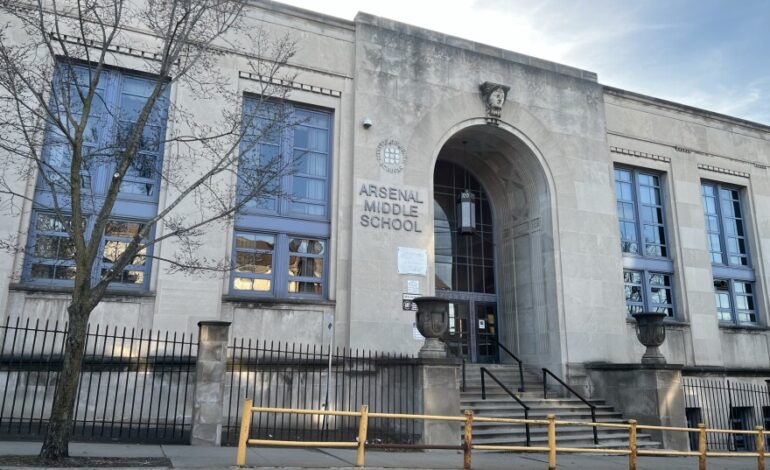Pittsburgh and Philadelphia Schools Face Closure Decisions Amid Enrollment Declines

The two largest school districts in Pennsylvania, the School District of Philadelphia and Pittsburgh Public Schools, are grappling with the potential closure of numerous schools as they seek to address declining enrollment and budgetary challenges. Both districts face issues related to aging facilities and varying school sizes, but their strategies for managing middle school education diverge significantly.
In Philadelphia, Superintendent Tony Watlington announced plans to consolidate the district’s current 13 grade-band configurations into just six. This proposal would eliminate all standalone middle schools, emphasizing a model that combines elementary, middle, and high school students within the same educational settings. Watlington indicated that this change is based on extensive research suggesting that fewer transitions between schools may lead to better academic performance for students. “This plan will reduce the number of standalone middle schools because our very detailed research indicates that students perform better with fewer transitions as they matriculate through their education,” he stated during a board meeting in June.
Conversely, Pittsburgh Public Schools, led by Assistant Superintendent Nina Sacco, has proposed a different approach. In a presentation in April 2024, Sacco shared the intention to transition schools back to more traditional models dedicated exclusively to K-5, 6-8, or 9-12 configurations. This move aims to create spaces that cater specifically to the academic, social, and emotional needs of students at different developmental stages.
Both districts’ closure plans have elicited mixed reactions from parents and community members. In Pittsburgh, some parents welcome the idea of dedicated middle school environments, while others express nostalgia for the community feel fostered by K-8 schools. The question remains: which structure is most beneficial for student development?
With approximately 250 school buildings, Philadelphia is significantly larger than Pittsburgh, which has 54 schools. The proposed changes in Pittsburgh would reduce the district to 39 buildings and dissolve the 11 existing K-8 schools. Reports from the Philadelphia Inquirer indicate that roughly one-third of Philadelphia’s school buildings operate below half of their capacity. Similarly, estimates based on 2021 data suggest that nearly half of Pittsburgh’s schools are also underused.
District officials in both cities contend that maintaining under-enrolled schools hampers their ability to offer rigorous and expansive course options. Last year, an analysis revealed that only 13 of the 23 schools serving grades six through eight in Pittsburgh provided Algebra 1, while just four offered foreign language classes.
The debate about middle school configurations has garnered attention from education experts. Mary Beth Schaefer, an associate professor of adolescent education at St. John’s University, expressed a preference for the standalone 6-8 model. She argues that while K-8 schools can be effective, the standalone model allows for a more tailored approach to meet the unique needs of middle-grade students. Schaefer emphasized that the key components of successful middle school programs include collaborative teaching teams, diverse course offerings, and advisory programs for emotional support.
“The magic isn’t in the grade configuration or the name you put on a building,” stated Katie Powell from the Association for Middle Level Education. “It’s about understanding developmental needs and ensuring that your programs reflect those needs.” Powell highlighted that successful middle school programs start with effective professional development to equip educators with a proper understanding of their students’ developmental stages.
In Pittsburgh, the district plans to establish three new professional development centers as part of its restructuring strategy. Officials believe that consolidating resources will enable more effective staffing, reduce fragmented responsibilities, and allow educators greater participation in ongoing professional learning.
Watlington’s presentation included findings that indicated fewer school transitions lead to better student outcomes. A study from the 1990s highlighted that students in K-8 schools outperformed their peers in district middle schools on standardized tests. Critics of this research argue that its benefits were mainly observed in more established K-8 schools serving higher-income students. A 2007 study from Johns Hopkins University noted that students in newer K-8 schools did not experience the same advantages, despite similar transition rates.
The ongoing debate about school structures continues to evolve. A 2019 study from Virginia suggested that middle-grade students performed better on state exams when attending K-8 schools. However, other recent studies indicate insufficient conclusive evidence to assert that grade structure significantly impacts effective middle school practices.
Retired middle school principal Bruce Vosburgh, who led a Chester County middle school for two decades, emphasized that successful transitions depend largely on how well school leaders manage the process. Vosburgh noted, “It’s important for schools to support parents through that transition, too.” He believes that a coherent curriculum that flows smoothly from grade to grade is essential for student success.
As both Philadelphia and Pittsburgh navigate these significant changes, district leaders must consider a multitude of factors, including enrollment trends, transportation access, and school building capacities. Powell remarked that no single study should dictate their decisions. Instead, she encourages districts to weigh various sources of data and ensure that their final grade configurations are responsive to student needs.
“Ultimately, schools should have the autonomy to make decisions based on their students’ requirements, rather than what may be most convenient for adults,” Powell concluded. The outcomes of these deliberations will likely shape the educational landscape for years to come in both cities.






